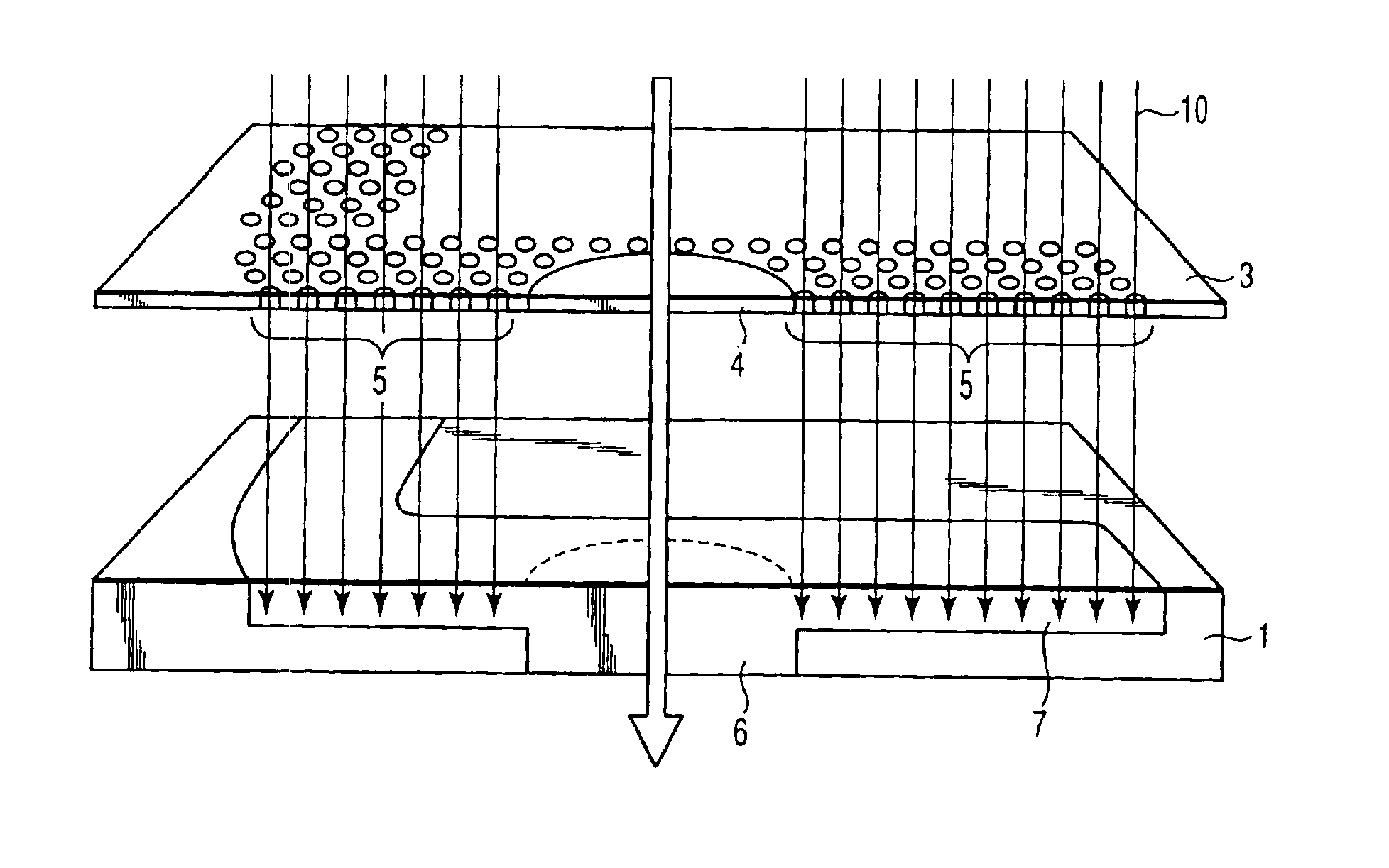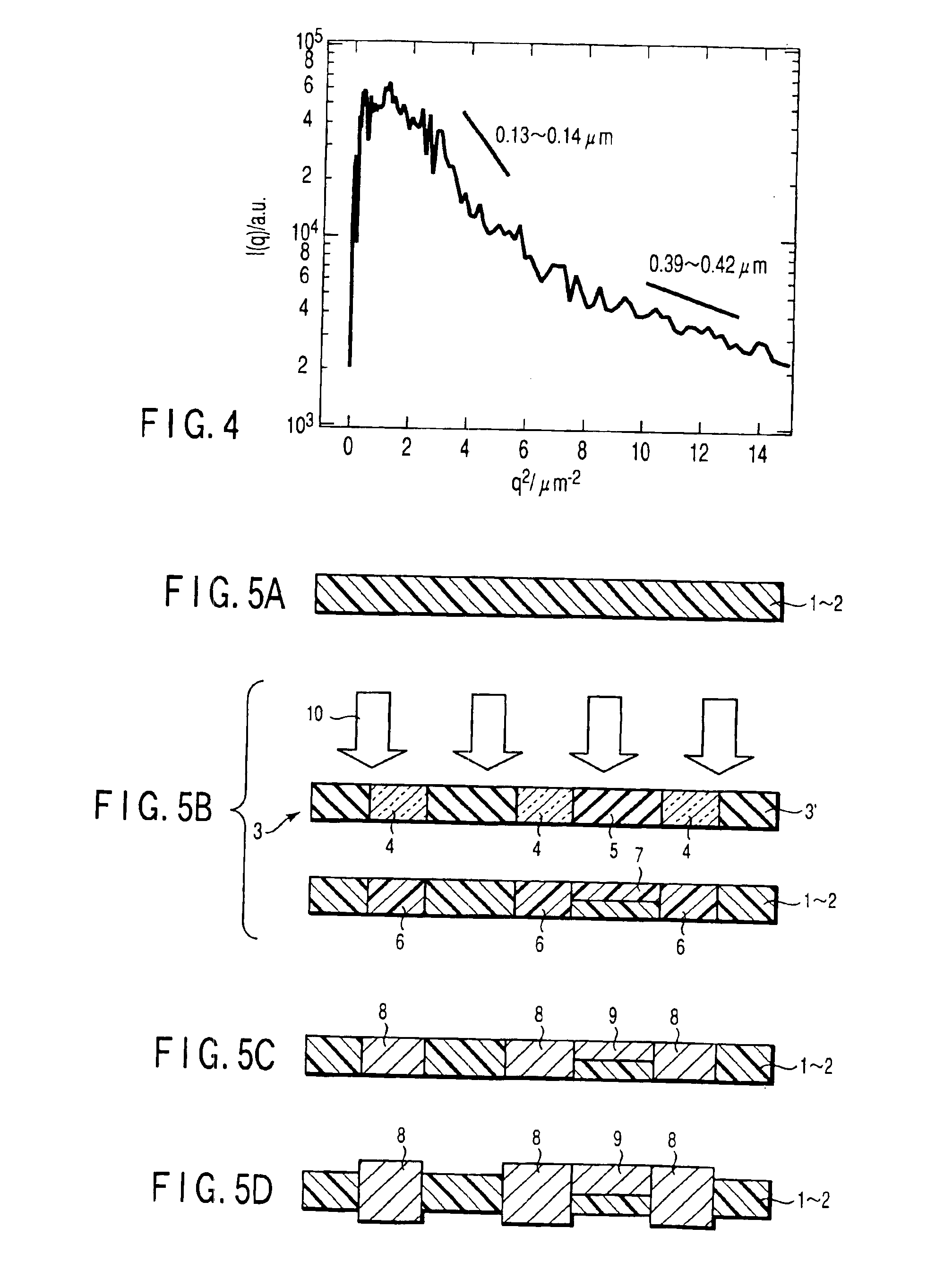Mask used for exposing a porous substrate
a technology of porous substrate and mask, which is applied in the direction of circuit mask, dielectric characteristics, instruments, etc., can solve the problems of difficult to easily prepare a fine wiring structure which is three-dimensionally free in configuration, difficult to improve yield, and dimensional porous film material degradation, so as to enhance the freedom of designing a conductive circui
- Summary
- Abstract
- Description
- Claims
- Application Information
AI Technical Summary
Benefits of technology
Problems solved by technology
Method used
Image
Examples
example 1
[0146]In this Example 1, the process for forming a wiring pattern in a porous insulating body by using a half-tone mask will be explained.
[0147]As a porous substrate, a PTFE porous sheet (the diameter of void: 500 nm, and the film thickness: 58 μm) was prepared. In the meantime, naphthoquinone diazide-containing phenol resin (the content of naphthoquinone diazide: 33 equivalent mol. %) was dissolved in acetone to prepare a 1 wt. % acetone solution as a photo-sensitizer, which was then coated on the entire surface of the porous sheet by a dipping method. As a result, not only the interior of the holes of the porous sheet but also the surface of the inner voids was covered with a photo-sensitizer.
[0148]Then, the resultant sheet was irradiated through a mask with a beam having a wavelength of 436 nm by using CANON PLA501 to generate an ion-exchange group at the irradiated or exposed portion. The mask employed in this case was a half-tone mask, the schematical construction of which bein...
example 2
[0157]In this Example 2, the process for forming a wiring and a via in a porous insulating body by using a mask having a fine pattern will be explained.
[0158]First of all, by the same procedures as employed in the aforementioned Example 1, a sample was prepared by coating a photo-sensitizer on the surface of an insulating body. Then, the sample was irradiated, via a mask and by using CANON PLA 501, with a beam having a wavelength of 436 nm, thereby enabling an ion-exchange group to be generated at the exposure portion. When the size of voids of the insulating body employed in this example was defined in terms of a radius of gyration as in the case of Example 1, it was 0.89 to 0.96 time as large as the wavelength of the exposure beam.
[0159]The mask employed in this example was provided at the wiring portion thereof with a fine pattern, a schematic view of which is shown in FIG. 7.
[0160]As shown in FIG. 7, the mask 30 was provided with a beam-transmitting region 31 for photo-sensitizi...
example 3
[0186]In this Example 3, the process for simultaneously forming a couple of wiring patterns on the opposite surfaces of substrate and a via in the substrate will be explained.
[0187]As a porous substrate, a PTFE porous sheet (the diameter of void: 600 nm, and the film thickness: 102 μm) was employed. In the meantime, a sample was prepared by coating the substrate with a photo-sensitizer by the same method as described in Example 1 except that this insulating film was employed as the porous substrate.
[0188]As for the mask to be employed for performing the exposure from the opposite surfaces of the sample, a mask comprising a top sheet and a bottom sheet each provided, at the wiring portions thereof, with a fine pattern was prepared.
[0189]The schematic structure of the mask employed herein is shown in FIG. 9.
[0190]As shown in FIG. 9, the mask was constituted by a combination of a pear of masks, i.e. a top surface exposure mask 40a and a bottom surface exposure mask 40b. These masks 40a...
PUM
| Property | Measurement | Unit |
|---|---|---|
| Length | aaaaa | aaaaa |
| Length | aaaaa | aaaaa |
| Fraction | aaaaa | aaaaa |
Abstract
Description
Claims
Application Information
 Login to View More
Login to View More - R&D
- Intellectual Property
- Life Sciences
- Materials
- Tech Scout
- Unparalleled Data Quality
- Higher Quality Content
- 60% Fewer Hallucinations
Browse by: Latest US Patents, China's latest patents, Technical Efficacy Thesaurus, Application Domain, Technology Topic, Popular Technical Reports.
© 2025 PatSnap. All rights reserved.Legal|Privacy policy|Modern Slavery Act Transparency Statement|Sitemap|About US| Contact US: help@patsnap.com



